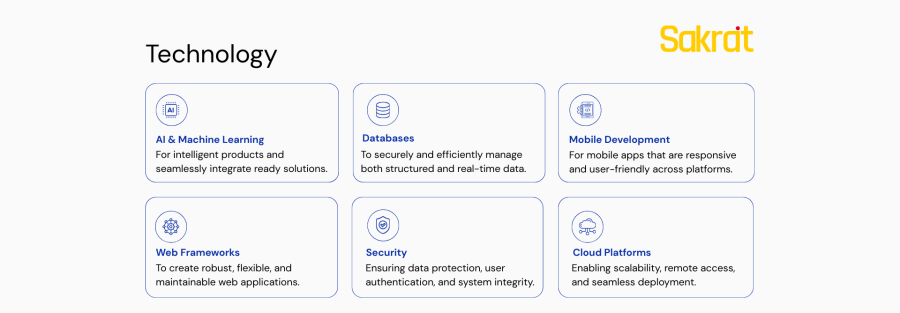How to Build a Scalable Tech Stack for Your Startup
For an early-stage startup, speed is everything. The pressure to build a Minimum Viable Product (MVP), validate your idea, and get to market before you run out of runway is immense. This often leads to a “build fast and break things” mentality, where technology choices are made for immediate convenience rather than long-term stability.
While this approach might get you to launch, it often creates a fragile, tangled tech stack that becomes a significant liability as you grow. The very tools that enabled your initial speed quickly turn into technical debt, slowing down development, frustrating engineers, and making it nearly impossible to scale.
The key to long-term success is to build smart from day one. A scalable tech stack is not about using the most expensive enterprise tools; it’s about making intentional, lean decisions that balance the need for speed today with the demands of growth tomorrow.
The Core Principle: Don’t Build for 1 Million Users on Day One
The biggest mistake a startup can make is over-engineering. You don’t need a complex microservices architecture and a massive Kubernetes cluster to serve your first 100 users. This premature complexity will kill your velocity. The goal is to choose a stack that is simple enough to move fast but flexible enough to evolve.
Step 1: Start with a “Modular Monolith”
The “monolith vs. microservices” debate is a false dichotomy for startups. The answer is a modular monolith. This is a single application (a monolith) that is internally structured into well-defined, logically separate domains (e.g., user authentication, billing, product catalog).
- Why it works: You get the developmental simplicity of a single codebase and a single deployment pipeline, which is perfect for a small team. However, because the code is logically separated, it becomes much easier to break these modules out into true microservices later when you actually need the scalability. This approach gives you speed now and options for the future.
Step 2: Choose Cloud-Native and Managed Services
Do not manage your own servers. This is a non-negotiable rule for a modern startup. Leveraging cloud-native infrastructure from providers like AWS, Google Cloud, or Azure is the single most important decision for scalability.
- Go Serverless When Possible: Use managed services like AWS Lambda or Google Cloud Functions for backend tasks. You only pay for what you use, and they scale automatically.
- Use Managed Databases: Services like Amazon RDS for PostgreSQL or MongoDB Atlas handle the backups, patching, and scaling of your database, freeing up your team to focus on building your product.
- Outsource Authentication: Never build your own user authentication system. It’s a complex security risk. Use a proven, scalable solution like Auth0 or Firebase Authentication from the start.
Step 3: Prioritize an API-First and Automated DevOps Culture
Your tech stack is more than just code; it’s the set of processes that allows you to deliver that code reliably and quickly.
- API-First Design: Even if you are only building a web app initially, design your backend with a clean API. This makes it exponentially easier to add a mobile app or integrate with third-party services later.
- Infrastructure as Code (IaC): Use tools like Terraform or Pulumi to define your cloud infrastructure in code. This makes your environments repeatable, prevents configuration drift, and allows you to spin up new testing or production environments in minutes.
- Automate Everything with CI/CD: From day one, set up a Continuous Integration/Continuous Deployment pipeline using tools like GitHub Actions or GitLab CI. Every code commit should automatically trigger a suite of tests and, if they pass, deploy to a staging environment. This builds a culture of quality and confidence, allowing your team to deploy small changes multiple times a day instead of doing large, risky deployments once a month.
A Practical, Scalable Tech Stack Blueprint for 2026
While every startup is different, here is a battle-tested, intentional stack that balances performance, cost, and developer availability :
- Frontend:
- React (with Next.js): Provides excellent performance, a great developer experience, and server-side rendering for SEO.
- Tailwind CSS: A utility-first CSS framework that keeps styling clean and maintainable without bloated CSS files.
- Backend (Choose one based on team expertise):
- Node.js (with Express or NestJS): Ideal for JavaScript-heavy teams and real-time applications.
- Python (with Django or FastAPI): Excellent for data-heavy applications and leveraging Python’s AI/ML ecosystem.
- Database:
- PostgreSQL: A reliable, flexible, and powerful open-source relational database that can handle almost any workload.
- Redis: For caching to ensure a fast user experience.
- Infrastructure & DevOps:
- Cloud Provider: AWS, Google Cloud, or Azure.
- Containerization: Docker for creating consistent development and production environments.
- CI/CD: GitHub Actions or GitLab CI.
- Infrastructure as Code: Terraform.
- Monitoring:
- Sentry or LogRocket: For real-time error tracking and performance monitoring.
Conclusion: Intentional Planning for Scalable Growth
Building a tech stack that scales with your startup is a strategic balancing act. You need the flexibility to move quickly and pivot when necessary, but also the foresight to avoid costly migrations and bottlenecks down the line. Start with a clear understanding of your business priorities, and select tools and platforms that offer both versatility and scalability. Cloud-native infrastructure, API-first design, modular code architecture, and automated CI/CD pipelines are non-negotiable in 2026.
A well-planned tech stack not only supports growth but also shapes your team’s culture, accelerates innovation, and reduces technical debt. Achieving this balance gives you the confidence to tackle new challenges and seize opportunities as your startup evolves.
Build for Tomorrow, Today
Ready to architect a future-proof tech stack tailored to your unique business goals? Contact our startup technology experts today for a personalized consultation and roadmap that ensures you build fast, smart, and scalable from day one.


